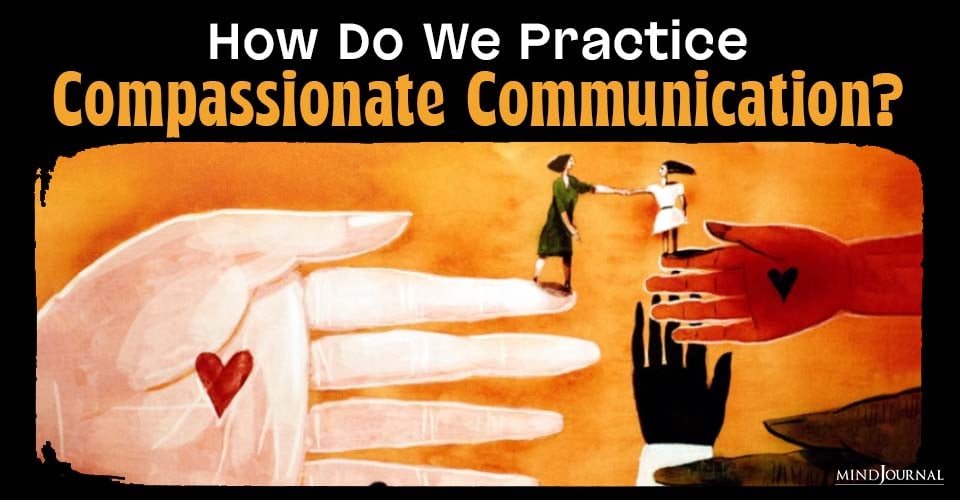What does it take to truly connect with others? Learn to practice compassionate communication in everyday life to ease their pain.
Five principles for compassionate communication.
Key points
- Compassion can be thought of as an empathetic, conscious effort to relieve the suffering of another.
- Mirror neurons allow us to experience one another in our minds.
- Embrace an openness to thoughts and experiences that may challenge your usual way of doing things.

I believe that compassion is the pillar for effective communication and is essential in growing your emotional intelligence. Compassion arises from tender acceptance centered in non judgment and can also be thought of as an empathetic, conscious effort to relieve the suffering of another.
One key to practicing compassionate communication is to recognize the emotions of others and to see ourselves in another. This is the power of a special type of cells in the brain that neuroscientists call “mirror neurons.”
Mirror neurons allow us to experience one another in our minds. Mirror networks in our brains are at play in our emotional understanding and in communicating with others. They fire when we see another in pain. They are essential to our experience of empathy. These networks help build our social connection. Through our brain networks of mirror neurons, we see one another, ourselves, reflected in each other’s smiles, frowns, eye rollings—in all that we do, we mirror one another.
Read More Here: Finding Our Purpose In Kindness
Practicing Compassionate Communication: 5 Great Ways
In my work, I have identified five principles for compassionate communication that can help you bring those mirror neurons in your brain online:
1. Practice mindful listening. Oh boy, this is a challenge for all of us! Much of the time, as someone else is talking, we are preparing what we are going to say. Listen, and don’t plan what you will say. When you listen fully, you may be joyfully surprised at how much more “in sync” you really are with others.
2. Open your mind. Be open to “try on” new concepts and ideas. Embrace an openness to thoughts and experiences that may challenge your usual way of doing things. Expanding out of your habits can really expand your thinking and boost your empathetic brainpower!
3. Practice focusing on yourself. This doesn’t mean to be selfish… recognize that your experience of the world is personal to you, while others may have different experiences, thoughts, feelings, backgrounds, or perspectives. When you speak, acknowledge that you are speaking only from your perspective, experiences, and behaviors. Importantly, do not speak for others or make assumptions about others’ experiences.
Try leading with phrases like “I feel…” or, “In my experience…” By acknowledging your perspectives as personal to yourself, you make room for others to speak and encourage connection. You might even learn something!
4. Have patience. Have patience when others respond, and let them ponder the why. Allow someone to respond within their own time frame. Being patient is crucial. No two brains are alike, and the processing speed of emotional information is unique to every person.
5. Practice the 24-hour rule. If I am experiencing a challenge with someone and it seems we are at an impasse, I practice the 24-hour rule. I give myself a good night’s sleep to allow time and space to offer me clarity. Next time you and someone may hit a roadblock, give yourself and them 24 hours.
Then, come back and see if you can find ways to find peace or at least some common ground. Finally, recognize that sometimes you still may not see eye to eye—and that’s OK! You can experience differences peacefully with space and time.
I hope that these principles and practices of compassionate communication will be of benefit to you and your loved ones.
“Our task must be to free ourselves…by widening our circle of compassion to embrace all living creatures and the whole of nature and its beauty.” — Albert Einstein
Explore more of Dr. Nicole Tetreault’s insights at www.nicoletetreault.com for transformative perspectives.
Read More Here: What Is Empathetic Listening? 9 Tips To Master The Power Of Understanding In Communication
Nicole Tetreault, Ph.D., is a neuroscientist, author, meditation teacher, and international keynote speaker on topics of neurodiversity, neurodevelopment, creativity, mental health, and wellness. Her book, Insight into a Bright Mind, explores groundbreaking research examining the experiences of unique, creative, and intense brains through interviews, storytelling, and literary science, while advocating for new directions of human diversity and neurodiversity.
Tetreault received her Ph.D. from the California Institute of Technology (Caltech) in neuroscience and has authored numerous academic papers on intelligence, autism, brain evolution, neuroinflammation, and behavior.
She is a professor at Bridges Graduate School of Cognitive Diversity in Education and teaches meditation, the complexities of neurodiversity, and neuroscience. As recipient of the Milton Career Exploration Prize from Caltech, she founded the novel non-profit Beyond the Cell, a transformative program to rehabilitate formerly incarcerated women and at-risk girls through guided meditation, dharma, neuroscience, and expressive writing.
As the founder of Awesome Neuroscience, Tetreault leads a new generation of meditation practices by fusing novel discoveries in neuroscience with the ancient lineage of Asian meditation.
She translates the most promising neuroscience and positive psychology into corporate trainings and meditation retreats, supporting people around the world in increasing creativity, deepening peace, awakening compassion, and wiring their minds for love.
Tetreault believes in our ability to wire our minds using positive neural plasticity through compassion and wisdom, liberating us to live the lives we dream.
References:
Häusser LF. Empathie und Spiegelneurone. Ein Blick auf die gegenwärtige neuropsychologische Empathieforschung [Empathy and mirror neurons. A view on contemporary neuropsychological empathy research]. Prax Kinderpsychol Kinderpsychiatr. 2012;61(5):322–335. German. doi: 10.13109/prkk.2012.61.5.322. PMID: 22957393.
Tennant K, Long A, Toney-Butler TJ. Active Listening. [Updated 2023 Sep 13]. In: StatPearls [Internet]. Treasure Island (FL): StatPearls Publishing; 2024 Jan. Available from: https://www.ncbi.nlm.nih.gov/books/NBK442015/
Schwartz-Mette RA, Rose AJ. Conversational Self-Focus in Adolescent Friendships: Observational Assessment of an Interpersonal Process and Relations with Internalizing Symptoms and Friendship Quality. J Soc Clin Psychol. 2009 Dec 1;28(10):1263–1297. doi: 10.1521/jscp.2009.28.10.1263. PMID: 20717490; PMCID: PMC2921802.
Hogan JN, Crenshaw AO, Baucom KJW, Baucom BRW. Time Spent Together in Intimate Relationships: Implications for Relationship Functioning. Contemp Fam Ther. 2021 Sep;43(3):226–233. doi: 10.1007/s10591-020-09562-6. Epub 2021 Jan 25. PMID: 34334944; PMCID: PMC8320759.
Share your thoughts on the principles for compassionate communication in the comments below!
Written by Nicole Tetreault, Ph.D.
Originally appeared on: Psychology Today










Leave a Reply